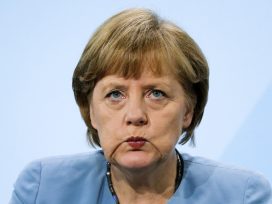In the following, I shall contrast three theoretical approaches to both understanding and justifying the realities of democratic capitalism and its (desired) mode of operation. Each of these theories specifies in a consistent and empirically validated way how the state, policy-makers, market actors in the economy and citizens act and should act. The three theories are the social democratic-cum-social market economy theory, the market-liberal theory, and an (as yet incomplete) theory that, for want of a better name, will here be sketched out under the clumsy title of “global financial market-driven post-democracy”. The latter is incomplete because it is well able to describe the “logic” that governs the realities of contemporary markets and politics but lacks the normative argument (an argument to the effect that the arrangements of the political economy and its mode of operation are actually universally beneficial) to demonstrate why these realities are justified and sustainable.
One: The social democratic theory of democratic capitalism
At the legal and constitutional level, democratic political rights guarantee civic equality – not, of course, the equality of socio-economic outcomes. Civic equality is normatively premised upon a strict separation and disjunction of (unequally distributed) socio-economic resources and (equal) political rights according to the principle of non-convertibility of the former into the latter. Ownership of economic assets should not be allowed to translate to privilege, political power, or a shortcut to access either. Correspondingly, inferior socio-economic status should not be allowed to deprive citizens of their political voice and its effectiveness. At the same time, it can trivially be observed that the actual use of political resources can have a major impact upon the relative socio-economic status and status security of citizens, as any democratically legislated tax law can serve to illustrate. This is the asymmetrical linkage between economic and political resources, or spheres of action: with the former being to some extent banned from being converted into the latter, yet the latter being allowed, in fact intended, to have an impact on the former.

Stock exchange. Photo: worradirek. Source: Shutterstock
This formula is the normative bedrock of the “social democratic” or “social market economy” normative theory of capitalist democracy: political power, reflecting prevailing conceptions of social justice and claiming primacy over the dynamics of markets, can legitimately shape the distribution of economic resources, but not the other way around. The social democratic theory shares two assumptions with the precepts of the “social market”. First, the economic process is one that is entirely shaped by and embedded in institutional arrangements and political decisions that have been framed at the political and constitutional levels. It is public policies that set into motion, license, regulate, and thus provide an institutional framework for market forces, such that the democratic state can then steer the economic process in ways that reliably avoid the twin dangers of devastating economic crises and disruptive social conflict.
The second assumption of the social democratic theory amounts to a theory of worker-citizens’ participation and “voice”: it claims that, given this confidence in the state’s regulatory and steering capacities and given the uneven distribution of life chances of capitalist social structures, there will be a “natural” tendency in all segments of the population, and in particular the less privileged ones, to make active use of the political resources that are granted to them as political rights. In such an institutional arrangement, there is a built-in incentive for citizens to make full use of their rights, as such use offers the prospect of cumulatively limiting socio-economic inequalities on the “output” side of state policies. More specifically, the less privileged strata of the population will have good reason to actually voice their complaints and demands for redistributive policies and greater (job and social) security. This is meant to result in a self-correcting dynamic that generates policies to reduce inequality and thus provide for social and political stability.
Two: The market liberal theory of democratic capitalism
An alternative theory of capitalist democracy, the “market liberal” theory, describes and prescribes a strictly symmetrical separation of markets and politics. As market power should not translate into political decision-making power, neither should the state and politics be allowed to intervene (more than marginally) into the market-generated distribution of resources. All liberal theories, particularly if combined with “pluralist” political theory, assume that under such symmetrical differentiation of political and economic spheres, neither of the two will have legitimate reasons to claim primacy over the other. While neither the state nor the market is fully autonomous, the mutual relations and inputs required cannot possibly amount to any relationship of dependency or robust prevalence. This theory, which found its most sophisticated elaboration in the work of sociological theorists, such as Talcott Parsons and Niklas Luhmann, describes a relationship between the democratic state and the capitalist economy as one of interdependence without primacy. The input that the political system provides to the economic systems is the legal guarantee of property rights, the enforcement of contracts, and the provision of infrastructural facilities and services. Conversely, the inputs coming from the economy are taxes on the one hand, and pluralist group pressures on the other. Given a highly diversified socio-economic structure, none of the organized groups that can mobilize political pressure is strong enough to impose binding demands on the political system; pressures also generate counter-pressures so as to cancel each other out, leaving the government free to give in and cater to this or that group.
Moreover, not all citizens in a “mass society” will actually belong to or identify with any particular group; yet many will belong to more than one group, however loosely (e.g., a trade union and the Roman Catholic church) – a situation that gives rise to the healthy phenomenon of “cross-pressure” at the micro level of voters and serves to mitigate the intensity of societal conflict. Nor does the pressure that one particular group can generate pertain to all policy areas equally, which further increases the freedom of discretion enjoyed by the governments of pluralist societies.
What does this stylized liberal theory have to say about patterns of political participation and its motives? Here the prevailing concern is with the systemic dangers of “excessive” mobilization and participation, which – according to the social-science doctrines of the fifties and sixties – was suspected as a source of instability, if not of “totalitarian” dangers (Huntington 1975). A political culture that leads people to stay passive or indifferent to most issues most of the time, combined with a sense of diffuse loyalty and support for the political system as a whole, is widely considered to be desirable for the sake of stability.
A further reassuring feature of liberal pluralist political theorizing is the axiomatic assumption, derived from Schumpeter, of a deep divide between political elites and non-elites that is modelled on the market transaction. Just as there is the hiatus between producers and consumers in markets, there is a divide between elite suppliers and non-elite consumers in politics. As dissatisfied consumers would never in their right mind consider invading the place of production in order to make their dissatisfaction heard, but would instead rationally switch to a competing supplier who better catered to their needs and tastes, so the democratic citizen is categorically assumed to be able to “exit” by changing to another supplier rather than engaging in verbal (or other) types of conflict with an unsatisfactory supplier/political elite.
Two-and-a-half: Post-democratic capitalism?
Both the social democratic and the liberal pluralist theories, as well as their implications concerning levels, kinds and social distribution of participatory practices, are now a largely obsolete matter of the past in both their analytical and normative aspects. They reached their expiration dates following the historical turning points that democratic capitalism experienced in the second half of the 1970s and again after 1989. What we are entirely lacking, however, is a theory or normative justification of the current realities, when economic resources do determine the agenda and decision-making of the political process, while the owners of those resources themselves, and the distributional outcomes caused by markets, are less and less constrained by social rights and political interventions. On the contrary, the latter are to a large extent put at the disposition of economic “imperatives.” Note that compared to the social democratic model, the present condition of globalized financial market capitalism-cum-endemic fiscal crisis is tantamount to an inverted asymmetry: markets set the agenda and (fiscal) constraints of public policies, but there is little that public policies in their turn can do in terms of constraining the realm and dynamics of the ever-expanding market – unless, that is, political elites are suicidally prepared to expose themselves to the second-strike capabilities of the “markets.” Yet it is this logic of a pervasive preponderance of accumulation, profit, efficiency, competitiveness, austerity and the market over the sphere of social rights, political redistribution, and sustainability, as well as the defencelessness of the latter sphere against the former, that governs the contemporary version of capitalist democracy (or rather “post-democracy” – Crouch 2004), and will probably do so for many years to come (Streeck 2011a). This logic, as it unfolds before our eyes and on a global scale, is sufficiently powerful and uncontested, it seems, to prevail through its sheer facticity and in the absence of any supporting normative theory – as a stark reality, stripped of any shred of justification.
In brief, the operation of this logic begins with the categorical denial of any tension between the rights of people and the rights of property owners, of social justice vs. property and market justice. To the extent the governments of nation states are in charge of the former and the addressee of respective demands and complaints, i.e. of “voice”, they are largely deafened by the overpowering and ubiquitous “noise” of the austerity imperative. The urgency of this imperative, and at the same time the difficulty to comply with it, is determined by three factors. First, there is a need to bail out failed (or potentially failing) financial institutions who count governments among their preferred clients. Second, governments cannot manage their financial troubles by raising taxes, because that would constitute a burden on private investors in the “real” economy and would disincentivize their continued (domestic) investment. Third, expenses cannot be cut because ever greater portions of the social security system, so far mostly covered by the “para-fiscal” mechanism of contributions, need to be covered out of general revenues (to the extent that transfers cannot be cut) in order to decrease the burden on employers. Cornered in this triangle of constraints, the state is no longer a plausible supplier of what all kinds of demand-side actors may desire it to provide. To gain any room for manoeuver at all, it is undergoing a creeping permutation from a classical (Schumpeterian) “tax state” into a “borrowing state.” That is, expenditures are not being covered out of present revenues, but out of (anticipated) future revenues – the prospective tax base of which, however, is itself being decimated by the increasing portions of state budgets that are spent on servicing debt (rather than on providing services and infrastructure). With Streeck (2007: 32, 34) we can speak of “emaciated state capacity” and the “attrition of its disposable resources.” The endemic fiscal crisis “pre-empts democratic choice” (Streeck 2010: 5); citizens simply have to get used to the fact that a fiscally starved state is the wrong interlocutor when it comes to demands concerning “costly” policies.
What are citizens likely to do? Four conceivable developments
This configuration of constraints leaves little space for the processes and institutions that supposedly make up the core decision-making site of democracy, namely party competition, elections, and parliamentary representation and legislation. After all, if decision-making on taxing and spending is off the agenda, a core function of parliamentary government is largely suspended. Instead, policy-making moves to other sites that are typically out of reach of the participant agents of normal democratic politics. All kinds of government-appointed commissions and fiduciary institutions (including central banks) are being endowed with de facto policy-making competencies, often of a supranational kind, as has occurred in ad hoc peak meetings of European (or G20) heads of government. These bodies, including the European Commission, are non-partisan in their composition and involved in transactions behind closed doors that put them by and large outside the democratic loop of transparency and accountability, as is the case for other instances of multilevel and multi-actor governance that tend to systematically obscure and anonymize the locus of political responsibility (Offe 2009).
Public authorities are seen as having lost their grip on key issues of fiscal and budgetary policy, and are driven instead by rating agencies and other forces of the financial markets. Since the neoliberal turn of he 1980s (when symptoms of participatory distortion began to show up in the data), they have also lost much of their control over the quality, price and distribution of public services in the name of efficiency, austerity, privatization, deregulation, private-public partnership, new public management, artificial voucher-driven markets, among others. As a result, growing numbers of the citizenry (particularly those who are interested in and depend on government social spending and services) have come to understand that participating in democratic politics is largely a pointless activity. We might speak of a dual control gap: governments lose control over taxation and the financial sector, and in response, citizens lose their confidence that the idea of democratic control over government policies is a credible one.
The obvious question that worries political elites as well as social scientists today is what citizens are likely to do instead. Obviously, it would be risky to expect that citizens’ retreat from politics into a mental state of alienated silence could be a steady state, although the media market does its utmost to make it so. Alternatively, there are four conceivable developments which commentators and analysts have been debating on the basis of recent political phenomena that can be read as early symptoms.
The first is what I call non-institutional “DIY politics” within civil society. Symptoms range from individuals engaging in critical consumption and consumer boycotts, to protest movements such as the Mediterranean indignados, to initiatives of civic engagement that organize through movements, donations and foundations, self-help, and private charity, in part as substitutes for inadequate public services. These forms of political participation, while highly selective in their (largely educated, urban, middle-class) social base, can achieve a great deal of sympathetic public attention and even the rhetorical support of political and economic elites.
The second is ephemeral eruptions of mass violence in metropolitan cities, as we have seen in the early years of this century, originating from (mostly) poor urban areas of London, Paris, Athens, and elsewhere. In contrast to the rebellions of 2011 in Cairo and other MENA cities, these eruptions are politically entirely unfocused and have provided partial cover for the unleashing of acquisitive and aggressive mass instincts. Recent events have put the “return of the violent mob” (Walter 2010: 214) on the social-science agenda. Wolfgang Streeck (2011b: 6) warns “that, where legitimate outlets of political expression are shut down, illegitimate ones may take their place, at potentially very high social and economic cost.”
A third alternative is further growth of the right-wing populism that has strongholds in the countries of central and south-Eastern Europe (Austria, Hungary, Bulgaria, Romania, Greece) and has surfaced, to a somewhat lesser extent, in France, the Netherlands and the Scandinavian countries. Key elements of the formula that has been used with remarkable success by rightist populist movements and parties are the strengthening of borders (against foreign goods, foreign migrants, and foreign political influence, e.g. from the EU) as a means to protect the “weak”; the intolerant and often aggressive denial of difference (from ethnic difference to differences of political views and opinions) in the name of ethnonational homogeneity; and the heavy reliance on charismatic leaders and successful political entrepreneurs. These parties and movements are the only political agents in the decades since 1990 that have managed to broaden their political base and enhance participation, albeit not the kind of participation envisaged by liberal democratic theory.
Finally, there is the intense, sometimes even desperate search, both in the social sciences (Smith 2005, 2009) and among various political parties, to deepen and enhance political participation through the introduction of new institutional and procedural opportunities that allow and commit people to raise their “voice” more directly, more often, and on more matters than representative institutions and political party competition have so far allowed them to do. While such projects of making democracies more democratic clearly deserve great scholarly attention and imaginative experimentation, political theorists should also look into the social conditions under which interests and political preferences are formed before they are voiced. After all, new procedures may not be sufficient to increase and broaden participation by citizens unless the supply of public policies and its “possibility space”, as perceived by citizens, is prevented from becoming ever more restricted, as in Lindblom’s (982) “prison” of the market, in which the author saw political life incarcerated.
References:
Colin Crouch (2004), Post-Democracy, Polity.
Samuel P. Huntington (1975), “The United States”, Chapter 3 in: The Crisis of Democracy, Report on the Governability of Democracies to the Trilateral Commission by Michel Crozier, Samuel P. Huntington and Joji Watanukim, New York University Press, www.trilateral.org/download/doc/crisis_of_democracy.pdf
Charles E. Lindblom (1982), “The market as prison”, The Journal of Politics 44, no. 2, 324-36.
Claus Offe (2009), “Governance: An ’empty signifier’?”, Constellations 16, no. 4 (2009): 550-62.
Graham Smith (2005), “Beyond the Ballot: 57 Democratic Innovations from around the World: A Report for the Power Inquiry”, Power Inquiry.
Graham Smith (2009), Democratic Innovations: Designing Institutions for Citizen Participation, Cambridge: Cambridge University Press.
Wolfgang Streeck (2011a), “The crisis of democratic capitalism”, New Left Review 71: 5-29.
Wolfgang Streeck (2011b), “Public Sociology as a Return to Political Economy”, Transformations of the Public Sphere, 30 September 2011, publicsphere.ssrc.org/streeck-public-sociology-as-a-return-to-political-economy/.
Franz Walter (2010), Vom Milieu zum Parteienstaat. Lebenswelten, Leitfiguren und Politik im historischen Wandel, vs Verlag für Sozialwissenschaften.








